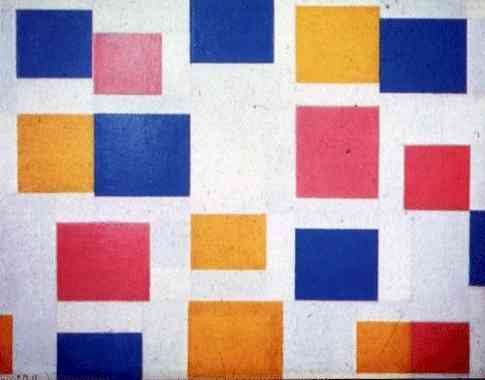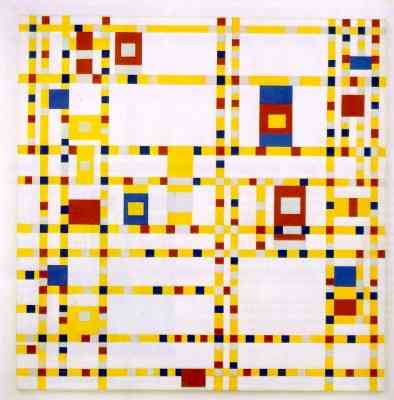For memory's sake
I am in love with Piet Mondrian's work. Omg. I love it. Cept his titles of his works are soooo dull. I wrote a paper about it:
...Intro=blah blah blah. Loreal riped him off, so did Jessica McClintock. Born, moved to Paris. Flourished. Moved back to Holland. Joined alliance with Leck and Doesburg called "De Stjil" or "the Style"....
Mondrian was greatly influenced by Leck’s work (see figure right: Composition 18 No.1 1918 by Bart Van der Leck) and his style shifted to reflect similar elements. Mondrian made a number of abstract paintings in 1917 in which he used bright rectangles of primary colors placed against a white background, very similar to Leck’s style. “Probably dissatisfied with the neutral space-suggesting character of this ground, Mondrian” began “[enclosing] his color areas with a strong grid of black lines.” These lines very soon became much more important than the color in between. A classic example in this change in Mondrian’s work is his “Composition in Blue (b)-1917”. He began to adopt, and visually embody the principle of “Neo-Plasticism” in suit with the other members of The Style. His aim became to “state the universal principles of balance and harmony” that he considered to lie behind life, but were not found perfectly expressed in nature. He wished to “reduce natural forms to contrast elements of form” or rather the relationship of horizontal and vertical and “natural color and primary”. In this way Mondrian felt that
he could eliminate personal factors “in favor of universal ones”.
After World War I, Mondrian moved back to Paris to his former address and continued his studies there. In 1925, Mondrian’s and Doesburg’s friendship was ended due to Doesburg’s rejection and blatant rejection of the principles that The Style was based upon. Doesburg began experimenting with the color green and diagonal lines. The Style could not survive with the remaining members, however, Doesburg advanced to create a new alliance called the “Abstraction-Creation”.
Although the former members of The Style continued with their ideals and principles, Mondrian explored Doesburg’s initiative and began conducting his own visual experiments with other colors and diagonal lines. During this time in his life, Mondrian noted that “Gradually [he] became aware that cubism did not accept the logical consequences of its own discoveries; it was not developing abstraction towards its ultimate goal: the expression of pure reality.” This shift in his ideals led his paths back to Doesburg’s once again and Mondrian joined the Abstraction-Creation.
Because of the threat of Nazi-Germany, Mondrian moved to London in 1938, but the bombing of London city by the Germans pushed him further west into New York City in 1940 along with many other European artists wishing to escape World War II. American influence is obvious in the work he produced during this time. Cities, being for Mondrian, “the embodiment of abstract life and therefore closer to him than any natural environment”, it was no surprise when Mondrian found himself in love with New York. He also fell in love with “boogie-woogie” music, to which he was introduced on his first evening in New York, and he soon began, as he said, to “put a little boogie-woogie into his paintings”. “Broadway Boogie-Woogie” (see image left) is directly reflected from this trend in Mondrian’s lifestyle and new fetishes. In this painting, as well as many of his other paintings, rhythm is very present. However, this piece is absent of his characteristic black, bold lines. This portrait of New York City was the last that Mondrian completed at the age of 70 before his death in 1944. The bold and distinct presence of yellow in this painting hints at how “enamored and exhilarated Mondrian was by the city of New York” and communicates the liveliness of the city. Richard Smith lightheartedly notes that Broadway Boogie Woogie is a bold painting for a man of 70 to paint”.
Mondrian’s passion, although evoked in the latter portion of his life, is present through all of his works, even in his earliest landscapes. Rather than intimidating, the works that he has the greatest recognition for communicate a formal feeling. Each line is carefully planned and thought out and his paintings seem to capture some simplified, parallel universe that extends beyond the boundaries of his canvases. His talent for precision and his embellishment and magnification of the “golden rectangle” and proportion fascinates modern mathematicians still. Joining a league of men including the Farmers of the Constitution and Benjamin Franklin, only differing in the materials that their genius best expresses itself, Mondrian’s work will continue to attract fans and attention. In a reciprocal way, his work is like a gruesome picture that one cannot force to himself to pull his eyes away from. In Mondrian’s case it is his simplicity and expertise in juvenile perfection is fantastically hypnotic.

Panes of Color

Broadway Boogie Woogie 1942-43

Composition with Large Blue Plane, Red, Black, Yellow, and Gray 1921

Lozenge Composition with Yellow, Black, Blue, Red, and Gray 1921
...Intro=blah blah blah. Loreal riped him off, so did Jessica McClintock. Born, moved to Paris. Flourished. Moved back to Holland. Joined alliance with Leck and Doesburg called "De Stjil" or "the Style"....
Mondrian was greatly influenced by Leck’s work (see figure right: Composition 18 No.1 1918 by Bart Van der Leck) and his style shifted to reflect similar elements. Mondrian made a number of abstract paintings in 1917 in which he used bright rectangles of primary colors placed against a white background, very similar to Leck’s style. “Probably dissatisfied with the neutral space-suggesting character of this ground, Mondrian” began “[enclosing] his color areas with a strong grid of black lines.” These lines very soon became much more important than the color in between. A classic example in this change in Mondrian’s work is his “Composition in Blue (b)-1917”. He began to adopt, and visually embody the principle of “Neo-Plasticism” in suit with the other members of The Style. His aim became to “state the universal principles of balance and harmony” that he considered to lie behind life, but were not found perfectly expressed in nature. He wished to “reduce natural forms to contrast elements of form” or rather the relationship of horizontal and vertical and “natural color and primary”. In this way Mondrian felt that
he could eliminate personal factors “in favor of universal ones”.
After World War I, Mondrian moved back to Paris to his former address and continued his studies there. In 1925, Mondrian’s and Doesburg’s friendship was ended due to Doesburg’s rejection and blatant rejection of the principles that The Style was based upon. Doesburg began experimenting with the color green and diagonal lines. The Style could not survive with the remaining members, however, Doesburg advanced to create a new alliance called the “Abstraction-Creation”.
Although the former members of The Style continued with their ideals and principles, Mondrian explored Doesburg’s initiative and began conducting his own visual experiments with other colors and diagonal lines. During this time in his life, Mondrian noted that “Gradually [he] became aware that cubism did not accept the logical consequences of its own discoveries; it was not developing abstraction towards its ultimate goal: the expression of pure reality.” This shift in his ideals led his paths back to Doesburg’s once again and Mondrian joined the Abstraction-Creation.
Because of the threat of Nazi-Germany, Mondrian moved to London in 1938, but the bombing of London city by the Germans pushed him further west into New York City in 1940 along with many other European artists wishing to escape World War II. American influence is obvious in the work he produced during this time. Cities, being for Mondrian, “the embodiment of abstract life and therefore closer to him than any natural environment”, it was no surprise when Mondrian found himself in love with New York. He also fell in love with “boogie-woogie” music, to which he was introduced on his first evening in New York, and he soon began, as he said, to “put a little boogie-woogie into his paintings”. “Broadway Boogie-Woogie” (see image left) is directly reflected from this trend in Mondrian’s lifestyle and new fetishes. In this painting, as well as many of his other paintings, rhythm is very present. However, this piece is absent of his characteristic black, bold lines. This portrait of New York City was the last that Mondrian completed at the age of 70 before his death in 1944. The bold and distinct presence of yellow in this painting hints at how “enamored and exhilarated Mondrian was by the city of New York” and communicates the liveliness of the city. Richard Smith lightheartedly notes that Broadway Boogie Woogie is a bold painting for a man of 70 to paint”.
Mondrian’s passion, although evoked in the latter portion of his life, is present through all of his works, even in his earliest landscapes. Rather than intimidating, the works that he has the greatest recognition for communicate a formal feeling. Each line is carefully planned and thought out and his paintings seem to capture some simplified, parallel universe that extends beyond the boundaries of his canvases. His talent for precision and his embellishment and magnification of the “golden rectangle” and proportion fascinates modern mathematicians still. Joining a league of men including the Farmers of the Constitution and Benjamin Franklin, only differing in the materials that their genius best expresses itself, Mondrian’s work will continue to attract fans and attention. In a reciprocal way, his work is like a gruesome picture that one cannot force to himself to pull his eyes away from. In Mondrian’s case it is his simplicity and expertise in juvenile perfection is fantastically hypnotic.

Panes of Color

Broadway Boogie Woogie 1942-43

Composition with Large Blue Plane, Red, Black, Yellow, and Gray 1921

Lozenge Composition with Yellow, Black, Blue, Red, and Gray 1921